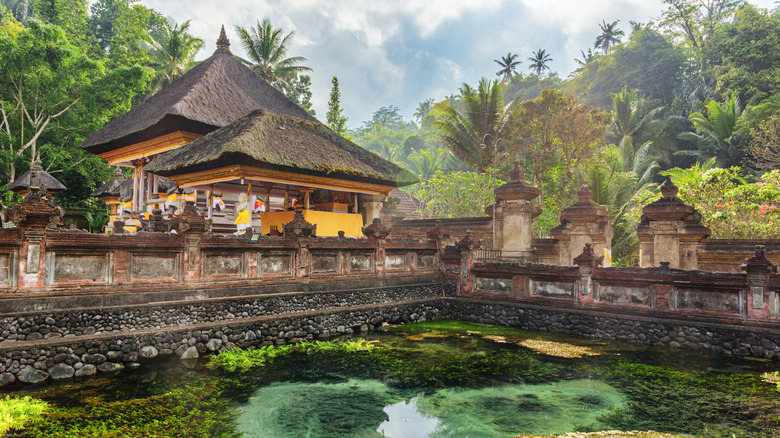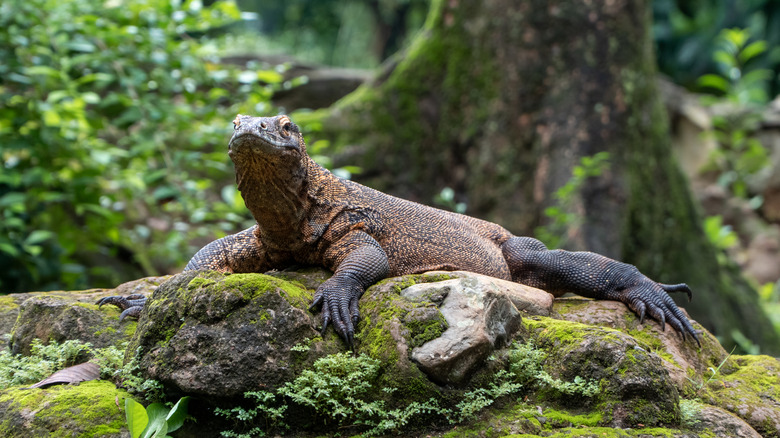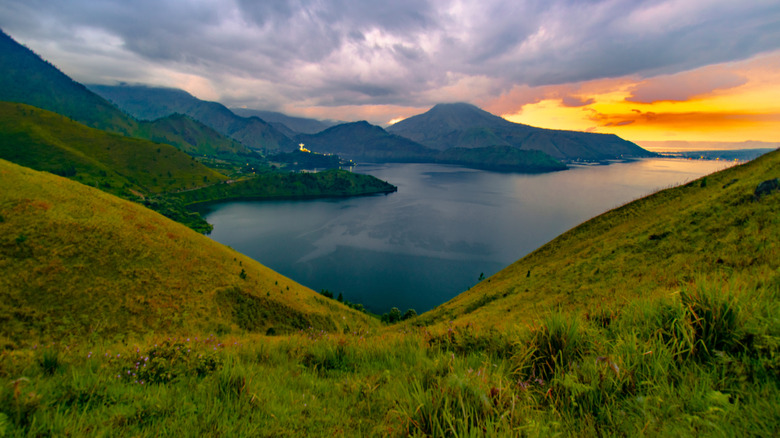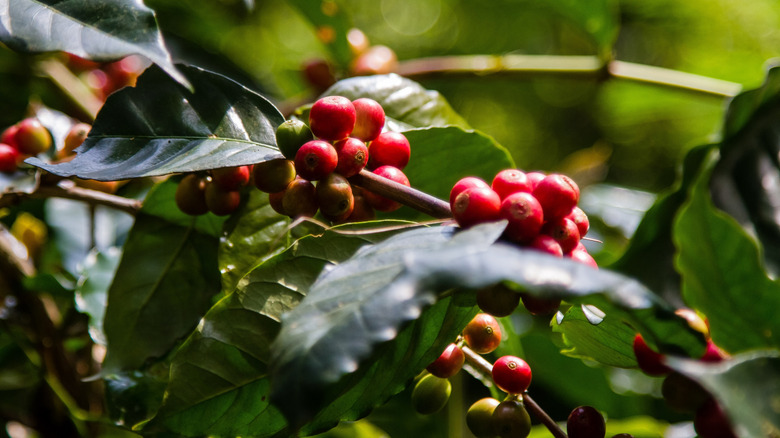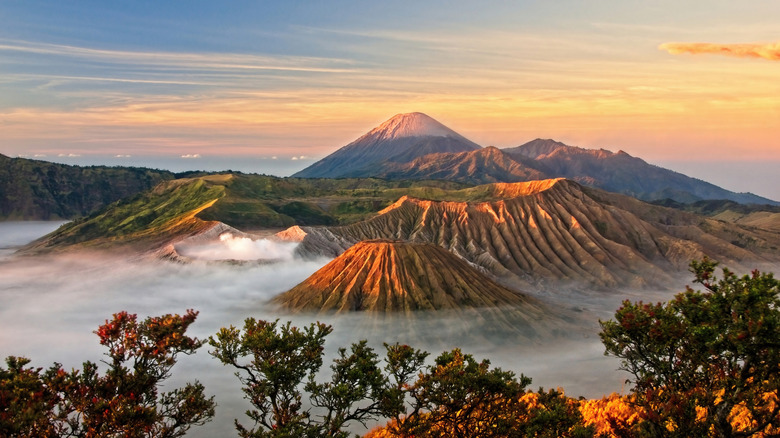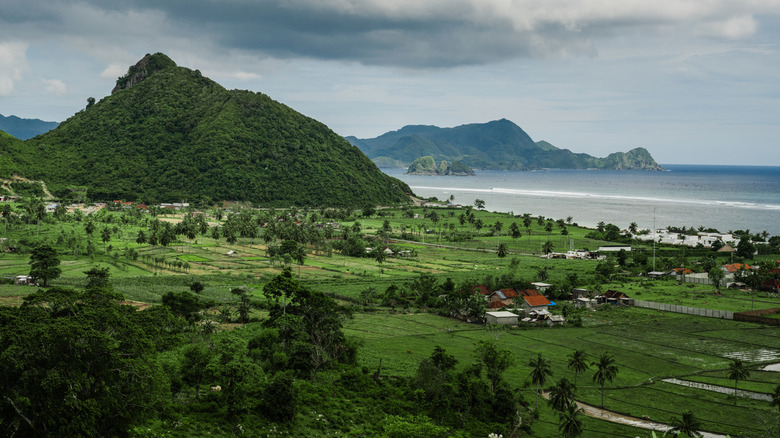Indonesia's 10 Must-See Tourist Attractions To Add To Your Bucket List
Indonesia is a nation of stunning contrasts. Across its more than 17,000 islands, travelers can find everything from the skyscrapers of Jakarta to the peaceful rice terraces of Bali. Many travelers don't realize that Indonesia is the world's largest island country; you could spend weeks (or even months!) exploring its islands without experiencing everything it has to offer. Indonesia is also one of the most ethnically diverse countries in the world, with over a thousand different ethnic groups. This, combined with its colonial past, which brought significant European influence to the country, has resulted in a blended culture that honors the past while looking forward. Travelers can witness this in the architecture and customs throughout the nation. Indonesia is unlike anywhere else on earth, and there are so many things to see during any trip here.
In this guide, we'll go on a journey through some of Indonesia's most iconic destinations, from the coffee plantations of Java to the world-famous Komodo National Park. Whether you're an adventure seeker, a culture lover, or a beach bum, this round-up will help you plan a bucket-list trip of a lifetime through one of the world's most breathtaking island nations that won't break the bank.
Borobudur Temple (Java)
Considered a masterpiece of ancient architecture, the UNESCO-designated Borobudur Temple in Central Java is the world's largest Buddhist temple. It's also one of Indonesia's most awe-inspiring sites. Constructed in the 9th century, the structure is an architectural marvel. Borobudur is a 95-foot-tall step temple that was created by stacking about two million river rocks tightly on top of one another. Among the many pieces of artwork that adorn the temple are 2,672 intricately carved panels — 1,460 on the wall and 1,212 along the pathway — and 504 statues depicting Buddha. There are an additional 160 carvings on the lower portion of the temple, but they are no longer visible, as they were covered by buttresses to support the weight of the structure. While Borobudur attracts visitors year-round, the Buddhist holiday Vesak Day is a particularly popular date.
Sunrise is widely considered the best time to visit. While you can certainly watch the sun come up from the temple dome itself, you miss seeing the structure silhouetted against the sky this way. Another option is to travel to the village of Karangrejo, about 10 minutes from the Borobudur complex. A local hill called Punthuk Setumbu is an excellent viewing point. Borobudur does not have an official dress code, but bear in mind that this is a religious site when you select your attire — if in doubt about what to wear, it's best to err on the side of modesty. Whether you arrive at this temple as a Buddhist pilgrim or simply someone who loves ancient history, Borobudur will leave a major impression on you for years to come.
Tirta Empul (Bali)
Appropriately built on the "Island of the Gods," Bali's Tirta Empul is one of Indonesia's holiest Hindu temples, renowned for its sacred spring water. The water here is believed by worshippers to have been created by Indra, the Hindu god of rain, storms, and weather. However, Tirta Empul is officially dedicated to Vishnu. The temple complex features shrines to Indra and Vishnu, as well as other Hindu deities, including Shiva and Brahma. Since its construction in the year 962, Tirta Empul has drawn locals and travelers alike. The Melukat spiritual purification ritual is one of the major draws for practicing Hindus. This traditional Balinese ritual involves participants kneeling by ancient stone spouts to cleanse their bodies, minds, and spirits. Here, participants symbolically wash away negative energy, physical ailments, and emotional stress.
There are 30 waterspouts at Tirta Empul, so the ceremony is intimate and deeply meaningful, but not overly small. Visitors are welcome to join the purification ceremony, though there are certain qualifications that must be met. Those who are menstruating, for example, should refrain from the ritual. Because of the deep spiritual meaning of this sacred experience, Tirta Empul provides everything from traditional sarongs for modesty to guides who help participants through every facet of the process. Of course, travelers can also watch the Melukat purification unfold without actively taking part. Whether you're seeking healing or simply want to immerse yourself in Balinese culture, Tirta Empul is a great bucket list spot on Bali.
Komodo National Park (Komodo, Padar, Rinca)
Spread across three islands — Komodo, Padar, and Rinca – in eastern Indonesia, Komodo National Park is a must-visit location that almost feels like entering Jurassic Park. Famed for being the world's only natural habitat for giant Komodo dragons, which have existed on Earth for about four million years, this is the site to visit if you want to feel like you've stepped into another world. A UNESCO World Heritage Site, Komodo National Park is home to about 5,700 of the iconic lizards and also plays host to savannahs, a pink-sand beach called Taka Makassar, and coral reefs that offer incredible diving. Unsurprisingly, visiting the Komodo dragons is this location's biggest draw, but viewing them must be done carefully. Though it is rare, these lizards do occasionally attack humans.
After taking a dragon adventure, explore the park's natural beauty with other activities. Go snorkeling or diving in various reefs that are home to an expansive array of marine life, including over 1,000 fish species, 260 known kinds of reef-constructing coral, and 70 types of sponges. Additionally, you might encounter sharks, whales, dolphins, or sea turtles during your time underwater. For those wishing to interact with manta rays, Manta Point near Komodo Island offers an incredible opportunity to get up close with these gentle giants. Hikers should consider climbing to the summit of Padar Island, where they will be met with an astounding view of tricolor beaches — white, black, and pink – below. For those wishing to do more than a day trip to Komodo National Park, Komodo Resort offers 26 private, air-conditioned bungalows.
Jakarta's Old Town, Kota Tua (Java)
As Indonesia's capital, with a population of over 10 million, Jakarta is an urban jungle complete with dozens of skyscrapers. If you want to step back in time, though, visit the city's Old Town, known as Kota Tua. Here, you can get a glimpse of Indonesia's colonial past; European-style buildings and cobblestone squares serve as a reminder that this was Batavia's commerce hub when the Dutch Empire ruled the island nation. Batavia was renamed Jakarta in 1949 when Indonesia overthrew the Dutch colonizers. Travelers should explore Fatahillah Square, which is the center of this neighborhood. Here, visitors will find street performers, the Jakarta History Museum, and other colonial buildings that make for great photos. Additionally, Kota Toa is home to the Wayang Puppet Museum, which has hundreds of traditional Indonesian puppets on display, and the grand Bank Indonesia Museum.
Kota Tua is also home to an emerging café culture. One of the most well-known local spots is Café Batavia, which has operated in a historic building since 1993. For an immersive experience in this district, travelers can take a self-guided walking tour. Among the most interesting stops are Gedung Cipta Niaga (the former International Credit and Trade Union), which still has remnants of Art Deco glamour, and the Kota Intan Drawbridge on the Big Canal. This bridge hails from 1628 and is the oldest bridge in the country. Although some parts of Old Town Jakarta are quite run down– and those in the know recommend sticking in the Fatahillah Square area for the nicest establishments — exploring the old port of Sunda Kelapa by boat is an option for more adventurous travelers.
Lake Toba (Sumatra)
Spanning 711 square miles, Lake Toba in North Sumatra is the largest volcanic lake on Earth. It is the permanent mark of a super-volcanic eruption that took place about 75,000 years ago, killing off multitudes of ancient species and significantly altering the topography of this region. Today, it's hard to imagine this peaceful lake in the midst of a fiery eruption. It is surrounded by beautiful foliage and villages. Samosir Island is considered by many to be the gem of Lake Toba. Approximately the size of Singapore, this island is a destination unto itself. Once they get off the ferry, travelers can explore Samosir's traditional Batak culture, known for its distinctive ornate wood architecture and music and dance traditions. Ambarita, an ancient Batak village, grew up around a sacred tree and is a popular stop. The Batak Museum in the village of Tonok is also a great place to learn more about local traditions.
Off Samosir, nature lovers can enjoy hiking to Sipiso-Piso Waterfall. Located on the north coast of Lake Toba, this waterfall is about 394 feet tall and plummets into a breathtaking gorge. Additionally, various water sports, including swimming, kayaking, and canoeing, are available to visitors. If you're looking for ultimate relaxation, check out one of the lake's hot springs. Pangururan Hot Springs (Aek Rangat, locally) and Sipoholon Hot Springs are both excellent options. If you're interested in staying near Lake Toba overnight, Marianna Resort & Convention Tuktuk or the incredibly affordable Samosir Villas (rates can be as low as $24!) offer exceptional views for the duration of your trip to this lovely locale.
Raja Ampat (New Guinea)
Off the coast of the island of New Guinea in Indonesia's West Papua province, Raja Ampat is one of the most spectacular marine environments on Earth. This destination lies at the crux of the Coral Triangle, which is home to almost three-quarters of the globe's known coral species, about a third of all discovered types of reef fish, half of the types of razor clam, and six of the seven sea turtle species. In addition to all of these impressive statistics, Raja Ampat houses the largest mangrove forest in the world. The colorful coral reefs here are undeniably beautiful, but they're also sacred to locals. For communities in this area, the water has long been connected to their way of life, not just as a food source but also as a connection to culture and spirituality. Now, conservation efforts are making Raja Ampat even more incredible than it was before. It is one of the only places where manta ray populations are not declining, for example.
Because of this commitment to preserving Raja Ampat holistically, visitors are able to experience what is arguably the world's greatest marine ecosystem, while simultaneously seeing the impact of sustainability and reef protection programs firsthand. Because of how remote it is, Raja Ampat is an absolute paradise for divers and snorkelers. It offers a chance to witness the underwater world at its most pristine and unspoiled. Among the best spots to dive are Cape Kri, Melissa's Garden, The Passage, and Manta Sandy. Most travelers get to this location by flying into Sorong (SOQ) from a larger airport, then ferrying to Waisai, Raja Ampat's primary harbor. Reaching Raja Ampat requires some effort, to be sure, but for those lucky enough to make the journey, it's a true bucket-list adventure.
Coffee plantations (Java)
The Dutch started to grow coffee in Java in the 1600s. The crop flourished as the ground here is naturally rich with volcanic soil, and Java is now one of the world's premier coffee-producing regions. It's so iconic, in fact, that the word "java" has become slang for coffee itself. Compared to Sumatran coffee, beverages from Java are generally smoother and earthier, with chocolate tones. For travelers, a visit to this island offers the rare opportunity to see how coffee is crafted from bean to mug. Visitors can tour working coffee plantations, many of which are still family-run farms. A number of plantations offer hands-on experiences, like allowing visitors to see how ripe coffee "cherries" are harvested, sun-dried, and subsequently roasted in small batches. It's also often possible to ask questions of local farmers.
Recommended stops include the historic plantations in East Java's Kawah Ijen, where a famous volcanic caldera formed 50,000 years ago, and Tugu Kawisari, which has the distinction of being Java's first coffee plantation. Founded in 1870, the farm's private coffee journey is a full-day experience for true coffee lovers. Some farms even offer lodging, giving travelers a chance to literally wake up and smell the coffee. Tugu Kawisari, for instance, has a plantation lodge where guests can book a room to stay overnight. And Central Java's MesaStila Resort and Spa is also located on a coffee plantation. Whether you're a diehard coffee drinker or simply curious about Indonesia's farming heritage, visiting a coffee plantation is a fascinating way to immerse yourself in local culture on the island of Java.
Mount Bromo (Java)
Another of Java's treasures, Mount Bromo, can be found in the Tengger Semeru National Park. It's one of Indonesia's most iconic natural features, and climbing to the peak is a rite of passage for adventurous travelers. Still an active volcano, Mount Bromo has been referred to as "Hell on Earth" for its steam vents, boiling holes filled with mud, and sulphuric odor. In spite of this moniker, the mountain is legendary for its beautiful sunrise views. If you are interested in driving yourself to the mountain summit, Probolinggo is the nearest town with public transit stops. Here, you can rent a vehicle or a motorbike if you want to brave Mount Bromo's twisting roads.
For those who prefer to leave their trek in the hands of professionals, Jeep tours are a readily available alternative to a DIY trip to the top of Mount Boro. Or, if you're feeling extra adventurous, you can hike to the pinnacle! No matter which way you choose to get to your sunrise viewing, it's important to note that you'll need to leave while it's still dark, usually around 2 a.m. or 3 a.m. After you've checked one of the world's most epic sunrises off your bucket list, you can head back to Probolinggo to explore. Some guided tours include both sunrise on Mount Bromo and other local wonders, like the Madakaripura Waterfall.
The Gili Islands (Near Bali and Lombok)
Just off the coast of Lombok and not far from Bali lie the Gili Islands — Gili Trawangan, Gili Air, and Gili Meno – forming a tropical trifecta that is well worth a trip. These car-free islands are the definition of island life, with stunning white-sand beaches, gorgeous water, and villas that will leave you wishing you could stay in paradise forever. Visitors and locals travel by bicycle or horse-drawn cart. Each island has its own personality. Gili Trawangan, nicknamed "Gili T," is the most lively of the trio, known for its active nightlife and sunset swings. Gili Air is known for chill beach bars and a welcoming community, while Gili Meno is the most secluded and is typically considered the best choice for honeymooners and dive enthusiasts.
As a matter of fact, the Gilis are known around their world for their snorkeling and diving. Shark Point is a great choice for experienced divers near Gili T, offering the opportunity to explore shipwrecks and, as its name suggests, encounter reef sharks. Near Gili Air, snorkelers can enjoy Hans Reef, which has a wide variety of tropical fish. Finally, in the waters near the snorkeling and diving jewel, Gili Meno, the Meno Wall and the Meno Slope both offer gorgeous coral reef views and the chance to spot sea turtles. For a one-of-a-kind experience here, dive or snorkel near the Meno Statues, an underwater art installation. Eco-savvy travelers will appreciate the Gili Islands' selection of sustainable villas and resorts like PinkCoco Gili Trawangan, Manta Dive Gili Air Resort, and Hani Hideaway.
Alas Harum (Bali)
A surprisingly family-friendly destination, Bali has all sorts of activities for vacationers. For travelers looking to experience many of Bali's offerings in a single, action-packed day, Alas Harum is the ultimate stop. Just outside Ubud, this destination offers a wide range of activities, from the famous Tegallalang rice terraces to curated photo op areas to adrenaline-pumping activities like ziplining, riding the sky bike (a suspended tandem bicycle), or swinging nearly 100 feet off the ground! Check out the Angel Swing – it has Instagram-worthy flower-covered ropes that make for gorgeous photos. Once you've done something a little bit wild, wander down to the calming rice fields, which offer scenic walkways and multiple photo spots from various vantage points.
Alas Harum is also home to one of the island's most accessible coffee plantations, where visitors can learn about traditional coffee-making methods and sample flavored brews, including Bali's own Kopi Luwak. There are also several restaurants on-site, each with its own vibe. Cretya Lite allows diners to enjoy ramen, cocktails, and traditional Balinese dishes with views of the rice terraces. Meanwhile, Cretya Ubud is Alas Harum's day club, where guests can reserve hammocks, terrace cabanas, or enjoy VIP experiences. Alas Harum is the perfect way to spend a day in paradise, especially for those who are short on time but still want to experience the magic of Bali.
Methodology
For this guide, we used a variety of high-authority sources, including official tourism websites for a variety of sites, such as the nation of Indonesia, Alas Harum, Komodo National Park, and Borobodur Temple, travel blogs like Exhausted Millennial, Urban Diaries, and Museum of Wander, among others, and well-respected resources like National Geographic, Britannica, and UNESCO. The result is a well-rounded guide designed for people traveling to various islands throughout Indonesia.


